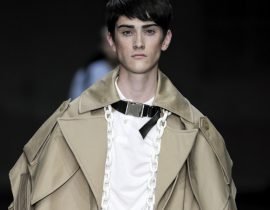




Dear Shaded Viewers,
Genaro Rivas, Peruvian-born and the recent recipient of the Visa x Vogue Business Young Creator Award, debuted his latest collection, A Feast for Crows, last month in Berlin. Now, with its London showing in an intimate church venue tucked between the city’s brutalist remnants, the SS26 menswear collection finds new resonance—anchored in shadows, symbolism, and an eerie kind of beauty that feels both old and futuristic.
While the looks didn’t exactly scream ecclesiastical garb—save a black jacket that echoed the silhouette of a clerical cassock—the spiritual setting certainly deepened the gothic romanticism that pulsed through the show. The collection found an atmospheric counterpart, amplifying its unsettling yet seductive mood.
Rivas has long been a designer concerned with duality—life and death, decay and opulence, structure and collapse. A Feast for Crows is perhaps his most distilled exploration of this yet. Inspired by the mythic imagery of crows in folklore—often seen as messengers or shapeshifters—and the cultural decay of modern-day youth, his garments balance severity with softness. The silhouettes were sharp: Nosferatu-like shoulders, nipped waists, and floor-sweeping hems that cut through the church’s nave like blackened angels.
But beneath the poetic darkness lies something quietly radical. The entire collection was crafted from recovered and sustainable denim, transformed through a technical symphony of zero-waste pattern-cutting, manual surface treatments, hand embroidery, 3D printing, and laser engraving. Rivas’ command of construction is both conceptual and fiercely methodical. Every garment is a study in sustainability, with meticulous attention paid to water usage, fibre circularity, and low-impact production methods. It’s fashion as ethical infrastructure.
This rigour extends to labor too. With 95% of the work carried out by women across London and Peru, the collection becomes not just a visual statement but a socio-political one. Ethical creation here is not sanitised or performative, it is highlighted in each look, expressed with a nuanced irreverence.
Rivas’ clothes speak in layers—visually and metaphorically. A loosely woven top teeming with sharp, silver embellishment felt like a push-pull motif dissecting strength and fragility. A high-collared coat adorned with an animal skull on the back hinted at mourning rituals both ancient and personal. And yet, nothing felt costume-like. Distressed garments were paired with clean-cut tailoring, denim was slashed with silver; a tension that kept the collection grounded firmly in fashion, not theatre.
The palette was predictably dark but never monotonous. Deep charcoals, weathered indigo, and flashes of silver hardware provided both a coherence to the collection and an air of regality. But there were also moments of surprising tenderness—a soft drape of fabric, or an exposed collarbone—suggesting that vulnerability, too, has its place in survival.
Rivas’ decision to show in London after Berlin felt both strategic and poetic. Berlin gave the collection its nihilist edge—concrete, underground, resistant. London, with its churches and historical baggage, offered context. In both cities, the collection felt eerily timely, especially as youth fashion continues to flirt with darker aesthetics, spiritual symbolism, and calls for responsibility. But A Feast for Crows isn’t about trend-chasing. These garments feel like relics of a future religion—clothing for a post-collapse generation seeking meaning in ruins.
Later,
Olivia

